
Welcome to Hyperion Records, an independent British classical label devoted to presenting high-quality recordings of music of all styles and from all periods from the twelfth century to the twenty-first.
Hyperion offers both CDs, and downloads in a number of formats. The site is also available in several languages.
Please use the dropdown buttons to set your preferred options, or use the checkbox to accept the defaults.

from notes by Angela Hewitt © 2001
extrait des notes rédigées par Angela Hewitt © 2001
Français: Isabelle Battioni
aus dem Begleittext von Angela Hewitt © 2001
Deutsch: Anne Steeb/Bernd Müller
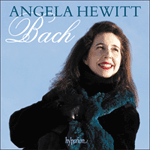 Bach: Angela Hewitt plays Bach Bach: Angela Hewitt plays BachAngela Hewitt’s acclaimed recordings of Bach on the piano have received the highest critical acclaim and found their way into thousands of homes, selling nearly 400,000 copies since her recording of the Inventions burst onto the scene in 1994. Now ...» More |
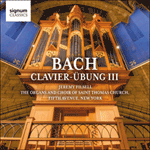 Bach: Clavier-Übung III Bach: Clavier-Übung IIIJeremy Filsell (organ), The Saint Thomas Choir of Men and Boys, Fifth Avenue, New York, Jeremy Filsell (conductor) Comprising twenty-one chorale preludes as well as the four duets, and opening and closing with the mighty 'St Anne' Prelude and Fugue, the third book of Bach's 'Clavier-Übung' is so much more than its somewhat prosaic title ('Keyboard Practice') m ...» More |
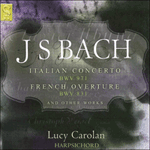 Bach: Italian Concerto & French Overture Bach: Italian Concerto & French OvertureA second volume of Lucy Carolan's recordings of Bach's keyboard music, including unique and constrasted pieces such as the Italian Concerto and the French Overture.» More |
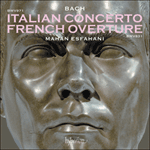 Bach: Italian Concerto & French Overture Bach: Italian Concerto & French OvertureMahan Esfahani again highlights the radicalism, virtuosity and sheer joyousness of all the works recorded here.» More |
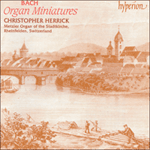 Bach: Organ Miniatures Bach: Organ Miniatures‘Just as, in my youth, I almost preferred to lick the scrapings from the bowls in which my mother had prepared cakes than to savout the finished produ ... ‘An attractive way of gathering up some of Bach's less obvious masterpieces, and they are all splendidly played, and recorded on a fine Swiss organ’ ( ...» More |
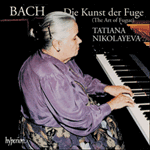 Bach: The Art of Fugue Bach: The Art of Fugue‘The remarkable Tatiana Nikolayeva … uncovers Bach's revelations as if they were her own’ (The Independent) ‘Absolutely superb. Certainly I can think of no finer recording of this endlessly fascinating masterpiece, whatever the medium. Highly recommended’ (C ...» More |
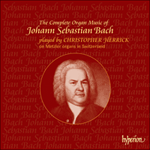 Bach: The Complete Organ Works Bach: The Complete Organ Works‘Let me say without hesitation that Herrick’s performances are models of clarity, accuracy, precision and musicality … this is a complete Bach th ... ‘Herrick is one of the few organists who does justice to these difficult, elusive pieces … What a singular joy to hear the organ played with such ...» More |
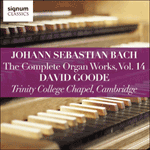 Bach: The Complete Organ Works, Vol. 14 Bach: The Complete Organ Works, Vol. 14This album presents the complete Clavierübung III of 1739. In many ways the crowning achievement of his organ works, Bach's compositional ingenuity is here unleashed on twenty-one Lutheran chorales in the first collection he prepared for publicati ...» More |

